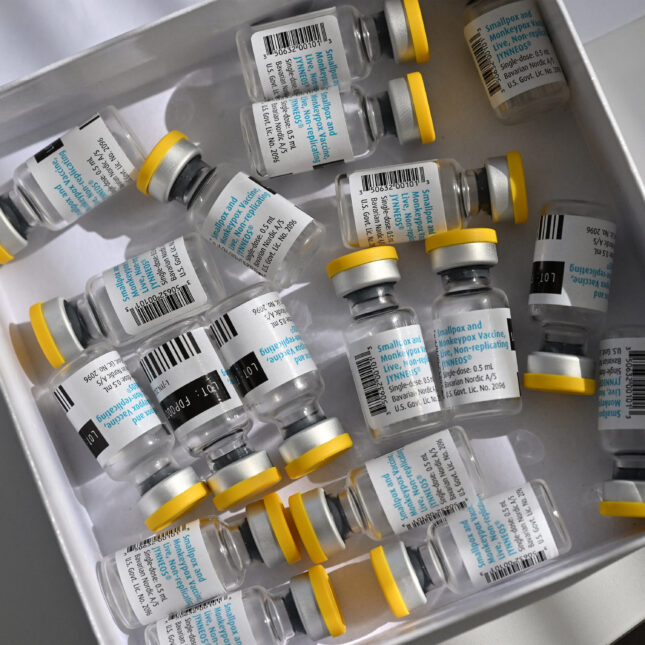
When mpox first began to spread internationally in 2022, affected countries scrambled to buy some of the limited supply of poxvirus vaccines produced in the world. The Danish company Bavarian Nordic, maker of the Jynneos smallpox vaccine, faced the sizable challenge of trying to meet demand with its supply.
This week’s declaration of a second public health emergency of international concern to deal with new and concerning outbreaks of mpox in Africa has again thrust the company onto center stage. The World Health Organization disclosed some projections of how much vaccine it thought Bavarian Nordic could make (cited in a STAT story here) that were rather quickly corrected by the company itself.
STAT caught up with CEO Paul Chaplin on Thursday to ask what Bavarian Nordic can actually produce — if purchasers place orders. To date the only order the company has received is one for 175,000 placed by the European Union’s Health Emergency Preparedness and Response Authority (HERA), which it is donating to the Africa Centers for Disease Control and Prevention. BN, as Chaplin refers to the company, has topped that up with a donation of 40,000 doses. The combined purchases and donation equal 215,000 doses, enough vaccine to vaccinate 107, 500 people. Jynneos is given in two doses.
The conversation has been lightly edited for length and clarity.
During the WHO press conference, someone from the agency listed a bunch of numbers, of doses you have on hand and doses you can make in the next year. I’ve read different numbers elsewhere. What is your inventory and your capacity?
I just want to put the situation in context. Before the 2022-2023 outbreak, we manufactured to order because we had relatively few orders. In the 2022-2023 outbreak, although we managed to supply everyone that requested it, it was a bit of a scramble because we had no inventory.
But we’ve been operating at the maximum capacity since the end of 2022. And we’ve been building up inventory for orders that we were anticipating that have come through this year, but also to have some surge capacity that we would be able to take vaccine that is in bulk and fill it rapidly in case there was another outbreak or large order.
The WHO was right. We did have just over 500,000 doses of inventory that we could immediately deploy. But 215,000 of that has already now been allocated through the HERA-Africa CDC-BN donation. So we still have 300,000 doses in stock — ish.
By the end of this year, we could manufacture another 2 million doses. And by the end of next year, it’s 10 million in total. So it’s all cumulative, not in addition to.
So another 8 million next year? Not even another 8 million, more like another 7.5 million?
Around that. And that’s along with everything else we’re already manufacturing.
Just so I’m clear, those additional 8 million doses that you could make next year, are they committed to anybody at this point? Or are we talking about a potential 8 million doses that could be made if somebody signs a contract?
The only doses that are now committed to the current African situation are the 215,000 doses. Everything else is available capacity that we can produce — if we receive orders.
What is the timeframe between signing an order for some of that capacity and delivery of doses?
The inventory that we have right now is doses. They are in vaccine vials, ready to go. Ship out tomorrow, if someone orders.
We also have inventory of vaccine in bulk, which takes a month or two to fill and release. So 2 million in total by the end of the year — is delivery.
If somebody signs a contract and says “Please use some of your capacity next year to provide me with 1 million doses,” how long would it take for you to fill that order?
If I had no inventory of anything and someone says “I want 1 million doses,” from the time I start ordering the raw materials to when vaccine doses go out the door, it’s more than one year.
But we’re operating at our max capacity. So we have a lot of raw materials coming.
That’s why we’ve decided as a company, we will have a rolling inventory to allow us to react more quickly because we knew. Maybe we didn’t really anticipate the next outbreak would be so soon after the last one, but we knew it was going to come and we knew exactly what would happen.
It feels a little bit now like we’re at the beginning of the 2022 outbreak in that, we’ve got the reported case in Sweden and we’ve got the situation in Africa.
That’s why we have this rolling inventory which allows us now to be in a much better place than we were in 2022, in that if someone says, “Can you supply 2 million doses by the end of the year?” the answer is yes.
Do you talk about per dose prices and whether you have pricing differentials depending on who you’re selling to?
We don’t tend to talk about price. Price is dependent on volume and also long-term commitment. So if we get a long-term commitment, we’ll give a discount and of course, the larger the volume, the more discount we can do.
We’re aware of the pricing constraints of certain organizations and we will do whatever we can. We’re happy to be part of the solution, but we’re only part of the solution. I think it’s really important that everyone understands: This is an international problem. And we are part of the solution, but we’re not the solution. And we are relying on others to step up and all together try and deal with this situation.
Who are you talking about there? Governments? Gavi? UNICEF?
I think all the organizations you just mentioned. Poorer countries will need financial assistance.
I think Covid and the last mpox outbreak should have taught the international community a lesson: You can’t ignore an outbreak that’s away from your border for too long without realizing that it eventually will come to your border.
The outbreak in 2022-2023 came from Africa. There is now a larger outbreak of a different clade in Africa. And if we don’t deal with it, it is only a matter of time.
Are you thinking about expanding manufacturing capacity? Or does the boom and bust nature of ordering dissuade you from that idea? You can’t make stuff you don’t sell.
In 2022-2023, we actually were in dialogue — serious dialogue — with several pharmaceutical companies, but also contract manufacturers to expand manufacturing. And we did actually bring a contract manufacturer in the U.S. on board, which is part of our overall capacity today.
But we were very, very close. And we even have contracts in place with companies that we could push the button at short notice to expand manufacturing. But third parties are only interested in taking things on if they’re receiving money. So again, this is all going to be dictated by orders.






